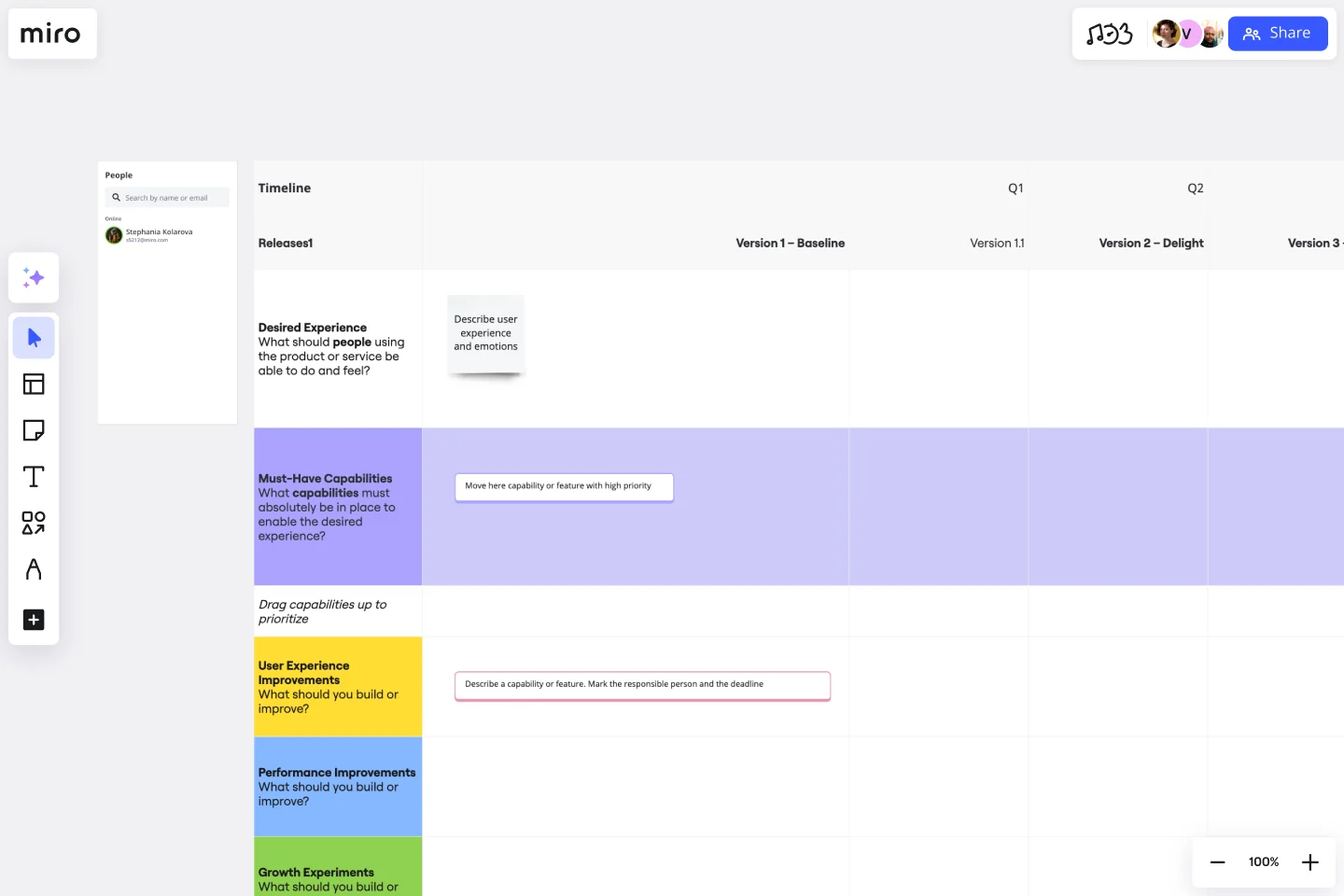Product Development Roadmap Template
Keep large, cross-functional product teams aligned around your product roadmap.
About the Product Development Roadmap Template
Product development roadmaps cover everything your team needs to achieve when delivering a product from concept to market launch. On the other hand, a product roadmap offers context and helps define short-term and long-term goals worth reaching.
Your product development roadmap is also a team alignment tool that offers guidance and leadership to help your team focus on balancing product innovation and meeting your customer’s needs. The product development roadmap is agile, so reiterate details quickly and often.
Investing time in creating a roadmap focused on your product development phases helps your team communicate a vision to business leaders, designers, developers, project managers, marketers, and anyone else who influences meeting team goals.
What is a product development roadmap?
A product development roadmap combines your product vision with your product strategy to build a detailed plan for how your team will get your product to market.
Ideally, your roadmap would answer a few key questions, such as your product goals and how you plan to achieve them, who will build the product, what your key milestones are, your current status, and how to get to the market launch phase.
When to use a product development roadmap
Product development roadmaps help your cross-functional teamwork towards a common goal, speed up your product’s time to market, and save time or money.
A product development roadmap is useful to help teams:
Decide on and work toward a focussed product strategy
Keep everyone motivated in the lead-up to a product launch
Help product owners plan and prioritize tasks
Understand a product’s strategic direction
Offer transparency to all stakeholders affected by decisions made
Product development roadmaps also help you decide on your success metrics and compare them to your business objectives. Ideally, you want to find opportunities to make incremental product improvements.
How to use the product development roadmap template
Making your own product development roadmap is easy with Miro's template. Simply add the product development roadmap template onto a new board, then follow these steps:
Set some clear goals for your product development
Your roadmap is less of a to-do list and more of a success strategy. Work backward from market launch to set goals and initiatives with your teammates. Make sure you have a compelling high-level vision and can communicate it both with internal teams and external stakeholders.
Agree on who has ownership of tasks with your team
Every item on your roadmap should have a clearly defined owner. That person then agrees to take responsibility for reaching the milestone in an agreed timeframe.
Monitor and update your roadmap as circumstances change
Milestones may change from quarter to quarter. Make sure cross-functional team dependencies (between UX, product, and development, for example) are kept up to date with changes.
Reprioritize goals as needed based on new information
The most successful roadmaps are the most up-to-date. Resources may shift, and priorities will change. Keep your product on track by thinking of this roadmap as a living blueprint rather than a static record, and update the template whenever changes occur.
Tip for Jira users: you can import Jira cards directly onto your product development roadmap template to visually organize and keep track of issues.
Discover more software product roadmap examples and create a clear visual roadmap.
Get started with this template right now.
Year Timeline Template
Works best for:
Timeline, Planning
The Year Timeline template provides a comprehensive view of annual events and milestones. Perfect for planning yearly goals, tracking progress, and scheduling important dates, this template helps you stay organized and focused throughout the year.
SMART Agile Product Roadmap
Works best for:
Product Roadmap
Plan and manage your product development with the Smart Agile Product Roadmap. This template supports agile methodologies, helping you outline product features, set timelines, and prioritize tasks. Visualize the development process, track progress, and adjust plans as needed. Ideal for product managers, development teams, and agile practitioners, it ensures your product roadmap is clear, flexible, and aligned with business goals, enhancing collaboration and productivity.
Design Brief Template
Works best for:
Design, Marketing, UX Design
For a design to be successful, let alone to be great, design agencies and teams have to know the project’s goals, timelines, budget, and scope. In other words, design takes a strategic process—and that starts with a design brief. This helpful template will empower you to create a brief that builds alignment and clear communication between your business and your design agency. It’s the foundation of any creative project, and a single source of truth that teams can refer to all along the way.
Fishbone Diagram for Marketing
Works best for:
Fishbone Diagram
Optimizing marketing strategies requires identifying underlying issues. The Fishbone Diagram Marketing template helps you systematically explore factors affecting your campaigns. Categorize potential causes into areas such as market research, product positioning, promotional strategies, and distribution channels. This structured analysis enables your team to pinpoint and address issues, enhancing marketing effectiveness and achieving better results.
Journey Map To Plot the Customer Experience
Works best for:
Customer Journey Map
A journey is a tool to map out the customer experience of (a part of) your product/service in a visual way.
Timelining
Works best for:
Planning, Timeline
Timelining is a versatile template designed for creating detailed project timelines. It allows you to outline tasks, milestones, and deadlines, helping you manage projects efficiently. Whether for business or personal use, this template ensures you stay organized and on schedule.
